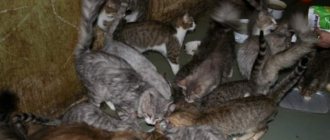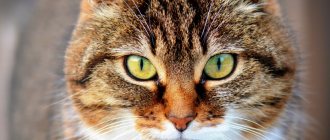The fishing cat or civet cat has recently attracted great interest among exotic lovers. There are also frequent attempts to keep it at home.
It should be remembered that this is not a breed of domestic cat, it is a natural variety of a wild predator. In order for coexistence to be comfortable for everyone, it is necessary to know everything about this rare species.
Captivity
Charismatic appearance and funny habits attract more and more attention to the civet cat. Many exotic lovers began to express a desire to keep the animal as a pet after the website of the famous fishing cat named John Davis, who lived with his owners for three years in the most ordinary apartment in the city of Krasnoyarsk, was widely promoted on the Internet.
This is the most famous fishing cat from Krasnoyarsk - John Davis
Taming
A wild animal will never be able to become a “plasticine” pet, and the Krasnoyarsk story is a clear confirmation of this. But if it so happens that you want to take a risk and repeat the attempt to tame an Asian cat, do not get a male, there is practically no chance of reaching an amicable agreement with him. Females of this species are much more docile.
Taming begins at an early age, no later than three months, until the kitten is able to naturally perceive a person as a member of its family. Contact must be established gradually, and in no case should you frighten the animal or put pressure on it. At the first stage, you should ensure that the cub learns to take pieces of food from your hands without any problems.
Taming and feeding a wild kitten will be simplified by your domestic cat
Aviary keeping is not suitable - if you want to get a truly tame pet, you will have to pay maximum attention to it and spend a lot of time communicating together. The fishing cat is very jealous and remembers insults well - this should also be taken into account. He may well find a common language with other cats and even with the dogs with whom he grew up in the house, but on occasion he will not deny himself the pleasure of hunting someone whom he considers weaker than himself.
The character of the “tame cat” is very complex
These animals are extremely intelligent and quick-witted, they very quickly perceive the rules of behavior in captivity and the hierarchy of their new pack. Usually, a fishing cat chooses only one owner, whom he considers the main one, and agrees to obey him. This stubborn cunning man can significantly ignore the demands of other family members
But he can show serious jealousy, protecting the attention of his beloved owner from other household members - but such moments are sometimes fraught with serious danger
Content nuances
The main problems when keeping a viverrid cat in captivity can arise when the animal enters puberty. Zoologists recommend castrating your pet in a timely manner; this will help stop manifestations of aggression and make the cat more manageable. But such measures will also not provide guarantees of unclouded coexistence of wild animals on the same territory as humans.
The fishing cat adapts well to the zoo environment
A cramped cage is disastrous for an inquisitive, active and mobile wild cat - it needs a lot of space and impressions: sufficient territory for walking and several different shelters. If there are good living conditions and adequate nutrition, a pair of fishing cats will quite possibly be concerned about procreation and bring forth charming offspring.
These animals have a very strong immune system and good resistance to infectious diseases. However, before changing teeth, it is necessary to vaccinate the kitten twice with a complex vaccine and then repeat the vaccination annually. There are cases where Asian cats lived in well-fed and prosperous conditions of captivity for up to twenty years.
The charming appearance of the civet cat is deceptive, and it is better to observe its behavior and habits from a distance. Do not experiment with keeping wild animals in your home, do not try to turn them into harmless fluffies. Nature cannot be fooled, and the habits of a wayward savage can take over, creating a serious danger for all the inhabitants of your home.
Note to the future owner
Despite the fact that obtaining permission to breed these animals is a lot of difficulties, professional breeders opening nurseries for fishing cats are multiplying at an enviable rate. This cat can only be purchased at a cattery. In this case, you need to choose a kitten less than 2 months old in order to socialize it as much as possible. When making a decision, first of all, you need to take into account your capabilities regarding keeping a predatory pet. You shouldn’t get an animal for selfish reasons to show off to your friends.
It is important to take into account that keeping a fishing cat and a domestic cat are completely different things.
In order for the baby to get used to the new owner as quickly as possible, he needs to be held in his arms more often and even hand-fed. The kitten should be constantly surrounded by people; it should see humans as a source of nutrition and comfort. Some owners set up a special corner on their property, like a zoo. A cat that is accustomed to living in a cage, separate from people, is unlikely to turn into a pet and will become a friend to a person.
Fishing kittens love to play, simulating hunting, and love to be petted, just like all other cats. Playing with an adult cat of such an impressive size is already dangerous, since she may simply not calculate her strength. Under no circumstances should a cat be punished if it accidentally bites or scratches its owner while playing. She may harbor a grudge or even stop respecting her owner. An animal that constantly communicates with a person begins to understand him by the intonation of his voice, so you can simply talk to a cat. Fishing cats are endowed with extraordinary feline intelligence, so they take their punishment very seriously. Some cats, depending on their individual characteristics, can react aggressively even to screaming.
Important!
Viverrid fishing cats, like all other cats, live according to the pack principle. They transfer the same model of hierarchy to the family in which they live and perceive themselves as part of it. The animal determines a leader, whom they obey in everything, and can consider itself a step above the other members of the pack. In general, animals treat children condescendingly in the same way as they would treat the cubs of relatives in the wild. Especially if these are the children of the leader. There have been cases when cats entertained crying babies with their purring and even protected children who were offended by adults.
Viverrid cats become sexually mature at the age of about 2 and a half years. An adult cat may begin to mark its territory, demonstrating that it is the owner. Therefore, it is better to sterilize males if they do not have breeding value or the owner of the cat does not plan to engage in breeding. It is advisable to castrate fishing cats before the age of eight months.
There was a case in Russia when one owner of a cat of this breed shared a story about what caused his pet to move to the zoo. Having reached puberty, the civet fishing cat began to be very enthusiastic about the “females” (women of the family in which he lived), protecting them from his rival (the owner of the family and his own breadwinner). The owners had no other choice but to part with their beloved cat by transferring it to the zoo. The owner emphasized that separation from his pet has become very stressful for all family members, without exception.
For this reason, it is worth thinking a thousand times about the decision to buy a wild animal and keep it in the house. There is a wide variety of large breeds of cats that are no worse than a fishing cat, but their maintenance is not associated with risks and large financial costs.
The civet fishing cat is native to Southeast Asia.
The very name of the breed says that civet cats live in close proximity to water, where they can always find enough food for themselves. Experts divide representatives of this breed into two types. They are practically the same in appearance, but the size of the fishing cats that live on the coast of Southeast and South Asia, including the island of Sumatra, is much larger than their relatives living on the islands of Java and Bali.
These large cats choose wet places located in the jungle as their place of residence. They feel great in mangrove swamps found in coastal areas, most often on island territories. They do not like to climb trees, as their body is very massive. The favorite pastime of the fishing cat is hunting for fish.
During the hunt, they wander through shallow water, and with a quick movement of their paws, equipped with sharp claws of substantial size, they pick up unwary fish. When hunting in water, fishing cats can also use cunning - keeping their bodies completely still, they lightly touch the surface of the water, imitating the movement of insects. Fish attracted by this movement become easy prey for the civet cat.
The fishing cat feels great on the water and in its deep places. The peculiarity of the structure of the paws, which have membranes between the claws, allows it to easily swim long distances. They say that civet cats, in pursuit of prey, even dive to shallow depths, and to prevent water from getting into their ears, they press them tightly to their heads.
Trowel.zh.rf
Want to know everything
But we have already studied a lot of wild cats! How can you not remember? I’m telling you exactly what it was, look here:
There is such an amazing exotic cat - the Asian fish cat, also known as the fishing cat, or vivverina. This cat lives and feeds near water. She is not afraid of water, swims well and is said to be able to dive to catch fish.
Felis viverrinus belongs to the class of mammals, order - carnivores, family - felines; lives in Southeast Asia in small areas of India, China, Vietnam, Thailand, Sumatra and Java.
The cat got its name because of its amazing ability to hunt in water. The uniqueness of the fishing cat is that all representatives of the cat family do not like and are afraid of water, but for the Asian fishing cat, water is its native element.
This cat lives and feeds near water. She is not afraid of water, swims well and is said to be able to dive to catch fish. Loves wet, marshy places near rivers and streams.
An adult male weighs from 11 to 15 kg, females are much smaller - 6-7 kg. The body length of an adult cat is 95.0-120.0 cm, the height at the withers is 38.0-40.0 cm. It has a strong build and great strength. The muzzle is short and wide; the ears are small, round, set low on the sides of the head; The jaw is round, the lower one is very strong, equipped with sharp teeth. The animal's head is round, set on a short neck. The fishing cat has short legs and a short and thick tail.
The cat's color is grayish-brown with speckled black, and there are black spots behind the ears. On the upper part of the body, the spots are located along the body, on the lower part - across. The end of the tail is dark. The forehead is decorated with longitudinal stripes or rows of spots.
There are membranes between the toes of the front paws that help the cat catch fish. During a hunt, a cat sits on the river bank and patiently waits for a fish to swim past. The fishing cat will never miss its prey: it hits the fish with its clawed paw and firmly places it on its claws as if on hooks. Sometimes this cat even dives to the bottom of the river for prey. Fish is a favorite food for this cat, but the cat does not disdain other foods: it also eats frogs, snakes, snails, birds, small mammals and carrion.
Fish cats breed all year round. Pregnancy in a female lasts 2-2.5 months, after which she usually gives birth to 2-3 kittens. After 9 months, kittens become adults. Males kept in captivity help the female care for the offspring, but how they behave in the wild is unknown.
The cat eats mainly fish. It also hunts toads, frogs, crustaceans, snakes, small mammals and birds. They can attack poultry, dogs, goats, and calves. It catches fish during daylight hours; at dusk and at night it can hunt for other prey. While fishing, a fishing cat sits on the bank of a stream or river and waits for fish to swim past, and when it does, it sharply hits the prey with its clawed paw.
The civet cat fisher can climb trees, but he does it reluctantly and does not like it. Loves to walk in shallow water and is a good swimmer. When swimming, it uses its short tail as a rudder. The fishing cat, like many cats, leads a solitary lifestyle. Each animal has its own individual territory.
Fishing cats have a reputation for being bullies and fighters, but they try to avoid meeting people. A case is described when one wiverina dispersed a pack of dogs. In some regions of Asia, there is a myth that a fish cat stole a newborn child from Singapore, however, this case is not documented. However, an interesting true fact is that a male fish cat kept in the zoo, a very large specimen, broke out of his cage and, entering the leopard’s cage, killed him.
Fishing cats caught at a young age are well tamed and become attached to people. The local population persecutes those cats who steal their poultry and devastate their fish stocks. The meat and skin of wiverin are used by Aboriginal people in folk medicine to prepare medicines.
There are two recognized species of fishing cat. The species found in Sri Lanka and along the entire coast of South and Southeast Asia down to Malacca and Sumatra are larger animals. Smaller representatives of the species live in Java and Bali.
The fishing cat is a rare animal listed in the International Red Book and the CITES Convention (Appendix II). The total population size does not exceed 10,000 mature individuals. Threats to the species: destruction of wetlands, poaching, pesticide pollution of rice fields. There are two recognized species of fishing cat (Felis viverrina), which differ in size: C. v. viverrinus - India, southern eastern Asia and Sumatra, S. v. risophores - Java and Bali.
Lifestyle and nutrition of a fishing cat
Although these cats are famous for their aggressive, bullying behavior, in the wild they avoid human contact. The difference between the speckled cat and most other representatives of the cat family is their good adaptability to the aquatic environment. These animals hunt not only near the shore, but directly in the water, in shallow water.
Viverrid cats have a reputation as fighters and bullies, but they avoid meeting people.
It is not difficult to guess that the main product in the diet of a fish cat is fish. The speckled cat hunts by sitting on the shore and using its paw to dislodge passing fish onto the shore, or dives after it to the bottom in shallow places. In addition to fish, the cat eats frogs, snails, birds and snakes. On land far from the shore, the fishing cat sometimes hunts insects, mice and small mammals.
Character, temperament
The civet cat is mainly nocturnal and always lives near water. It can climb trees, but very rarely does this; it mainly wanders in shallow water in search of prey.
Very smart and cunning, luring the victim, it hits the water with its paw. When there are ripples on the surface of a reservoir, underwater inhabitants think that this is the movement of insects and rise to the top. An adult is capable of swimming long distances, up to several kilometers.
Sexually mature females and males lead a solitary lifestyle, carefully marking their habitat with their own scent, secretions and claw marks on trees and protecting their territory. So, a female is able to control from 6 to 8 square meters. km., and the male from 16 to 22.
When in danger, adult animals make a characteristic sound reminiscent of laughter.
These are very brave animals, capable of even coping with a leopard or a pack of dogs alone, but they always avoid meeting people.
The speckled cat is available for socialization. The behavior of a civet cat when living next to a person is described below.
History of the discovery of the variety
Fishing cats have been known to the indigenous populations of many Asian countries since ancient times. These animals preferred to hide in the thickets of the tropical jungle during the day, so for a long time there were only legends about the ghost cat.
During the development of new territories, extensive deforestation and drainage of wetlands began. Viverrid cats had to adapt to new living conditions; they became more noticeable to people and, unfortunately, became objects of hunting.
Hunters continue to catch civet kittens for sale, despite the fact that in most countries in the animal's natural range, these actions are punishable by law.
The name of the species was given by the English zoologist and writer Edward Turner Bennett in 1833, having described in detail the morphology and color of the cat, which in India was called “fishing cat”.
In 1958, the name Prionailurus was proposed to the new species by the Russian researcher and naturalist Nikolai Severtsev as a common name for the spotted cat species of Asia, and the name Felis viverrinus rhizophoreus was given by the Dutch scientist Henri Jacob Victor Sodi in 1936. He described in detail the Viverrid cat caught on the coast of West Java. This individual has a slightly shorter skull than specimens previously found in Thailand.
The name Speckled is associated with the fur pattern - the cat's entire body is covered with dark specks.
Viverrid means similar to the tropical predatory mammal civet or civet, mainly due to its secretive lifestyle. The cat is called a fisherman due to its preferences in hunting, fishing and nutrition.
The names of the predator in local dialects are also interesting. In Assamese it is Meseka (fish), in Bengali it is Maha-bagrol or Bagh-Dasha. Maha means fish and Bagha means tiger. In Hindi, the name of the Fishing Cat sounds like Ban-Biral, in Telugu - Bavuru-pilly (wild cat), in Sinhala - Handun Divya, in Thai - Sea-Pla (fish tiger). In Myanmar, this predator is called Kuanga-ta-nga. "Kuanga" means "cat" and "ta-nga" means "fisherman".
Wild predator at home
The fishing cat is a representative of a wild breed. Initially, he is a predator living in the wild. In many countries of the world, the breeding of these cats is prohibited, which is due to their rather difficult character - viverrid cats have won the title of fighters and bullies, and they conflict not only with other forest dwellers, but also with their own kind.
However, despite its behavioral characteristics, the civet cat is a very desirable pet. Potential owners are not afraid of either possible problems with his upbringing or certain difficulties associated with keeping him.
And even the fact that a fishing kitten raised next to people can later turn out to be quite controversial does not stop exotic lovers. Recently, professional breeders are increasingly turning their attention to this attractive predator and, having received permission to breed it, are opening new civet cat nurseries
It is necessary to purchase a civet kitten at the age of no more than two months and only in a specialized nursery
Content Features
Raising a fishing cat should be approached with all responsibility and at the same time have certain knowledge related to the specifics of keeping such animals. And since this predator is listed in the Red Book, in order to purchase it you will also need a special permit.
What owners should remember:
- It is necessary to socialize the baby from the first day of his arrival in the new home: feed him by hand, stroke him more often and give him a lot of attention. This way the kitten will quickly get used to both the environment and the breadwinner. In addition, it is desirable that he be among people as often as possible and have the opportunity to move freely throughout his territory.
- During games, it is undesirable to let the kitten bite your arms or legs, as it may not calculate its strength and cause serious damage in the excitement. To do this, use only different toys and teasers. If the animal nevertheless gets carried away and scratches you, then in this case it is not allowed to scold it, much less beat it. Otherwise, the predator will begin to defend itself and then the consequences may be much more severe. To pacify a cat, it is enough to clearly tell it “No”, while your voice should be stern, but not too loud.
- Viverrid cats in nature live in packs, and therefore such a pet will also consider your family a pack. And at the same time, he will demand attention from all its members without exception.
- If the pet has done something wrong, then as punishment it should be left alone in another room for a while. This cat is very smart, and therefore will definitely understand what to do next time so that no one will be offended at her again.
- At the age of 2-3 years, a fishing cat may begin to experience certain behavioral problems associated with puberty. The male will begin to mark his territory, and attacks of aggression towards other pets living with him in the same house are also possible. To avoid these and other troubles, it is advisable to castrate the animal, but no later than 8 months of age.
In general, if you approach the upbringing of a fishing cat competently, then it is quite possible to make him an affectionate pet.
But if you are not sure, then it is better to turn your attention to representatives of other breeds
https://youtube.com/watch?v=An05wY1NE4c
[edit] Distribution and protection
The range of fishing cats covers scattered areas of the Indomalayan biogeographical zone. They are common in peninsular India, Sri Lanka, Malaysia, Thailand, Pakistan and Java. They inhabit mainly wetlands, as well as dense forest areas adjacent to rivers, jungle areas, reed and bush thickets. They live at altitudes of up to 2100 meters above sea level.
A major threat to fishing cats is the destruction of their habitat, especially wetlands. For example, in Sri Lanka, it has been documented that various factors such as land reclamation, untreated water discharge, clearing of natural vegetation and general environmental pollution are responsible for habitat loss. In addition to habitat loss, fish cats are suffering from overfishing caused by destructive fishing practices, as well as poaching for food and harvesting of various body parts for medicine.
Fishing cats are listed on Appendix II of CITES. They are protected by national legislation throughout most of their range. Hunting of fish cats is prohibited in Bangladesh, Cambodia, China, India, Indonesia, Myanmar, Nepal, Pakistan, Thailand and Sri Lanka. Regulated hunting is practiced in Laos. In Bhutan and Vietnam there is no protection outside protected areas. The conservation of this species depends primarily on adequate protection of Asian wetlands, as well as on the prevention of poaching.
The International Union for Conservation of Nature considers the fishing cat as an endangered species.
Is it possible to keep a viverrid cat at home?
Fishermen are predators living in the wild. Their behavior is unpredictable, and their habits do not correspond to the behavior of a cute pet. In many countries around the world, captive breeding of these animals is prohibited, due to the pugnacious nature and rarity of the breed. However, exotic lovers are not deterred by the fact that the predator can grow uncontrollable and cause a lot of problems for the owners.
Breeders do not miss the opportunity to make money on this. They open civet cat nurseries, offering everyone who wants to have exotic animals at home.
Place in an apartment or an enclosure?
In the wild, these predators avoid humans, but do not show aggression. Taken home very young, they adapt well to the home lifestyle and can become loyal friends. It is better to choose females that cause fewer problems in adulthood. Male animals can mark territory and be jealous of strangers, protecting their owner from them with their claws and teeth.
Raising a kitten requires a special approach and time, and it must begin from the moment the baby appears in the house. You need to hand feed him, pet him, and communicate with him a lot. It is advisable for the pet to live with family members, and not in a separate enclosure. In this case, he will be more sociable and tame, and will not remain an independent wild predator.
It should be borne in mind that an exotic pet will not deny itself the pleasure of feasting on those who are weaker than it, so you should not leave it alone with other pets. It should also be remembered that the natural instincts of an adult can take precedence over upbringing at any moment. Then the animal will become dangerous to people.
How to walk a cat?
Viverrid cats are freedom-loving animals that need space. They are cramped even in a country house; they need daily two-hour walks. They walk this unusual pet on a harness, allowing you to explore the secluded corners of the territory. Animals do not tolerate cold well; for walks in the autumn-winter period they will have to be dressed warmly.
Anglers should be taught the litter box and the rules of behavior in the house from childhood, stopping unwanted actions with a stern voice (in extreme cases, you can use an air pump to scare them away). The pet must be rewarded for its success with affection and treats. During games, you need to be careful not to allow the animal to bite or scratch, otherwise the game will quickly develop into a hunt for him, and he will perceive the owner as prey. If the cat has seriously misbehaved, you can lock him alone in the room for a while.
What to feed your unusual pet?
Animal nutrition should be as close as possible to their natural diet. They should be able to catch a fish, gut a game, catch a frog. The energy requirement of domestic pets is less than that of their wild relatives, but the animal's daily diet should consist of 1–1.5 kg of poultry or fish. Once a week you can arrange a half-starvation day by offering chicken or quail eggs, fresh herbs. After consulting with your veterinarian, you should choose vitamin and mineral supplements.
Health and hygiene
Domestic fishing cats live about 12–15 years. Caring for him should be as thorough as for cats of other breeds. Animals have their nails trimmed and their ears cleaned. You should be accustomed to such manipulations immediately, since in adulthood the animal can get scared and injure the owner. The fur of fishermen practically does not shed, which simplifies its maintenance.
Domestic cats of other breeds are reluctant to go into the water. However, for a fisherman cat who loves to swim, it is advisable to organize a small pool in the garden. From time to time it is worth introducing live fish there and bringing frogs to the animal. In this case, the pet will be able to realize its hunting instinct. When keeping a predator in an apartment, a bathtub will help out, where the civet cat can splash around. To make it interesting for him, you can throw toy fish into the water.
By nature, predators have good health and strong immunity. However, they need preventive vaccinations. The first vaccination should be carried out before teeth change, and then repeated annually. At 2–3 years old, cats begin to mark their territory, so if there is no desire to use them for breeding, the pet must be neutered no later than 8 months.
Description of the fishing cat
Like most wild predators, the appearance, habits and character of a fishing cat are entirely dependent on natural conditions. After all, hunting for prey is a process on which the life of a cat and its offspring depends, so it is necessary to have a coloring that is consistent with the general nature and a strong body.
The animal swims and dives well in search of prey
External data
An adult civet fishing cat weighs up to 15 kg. The body can be from 96 to 120 cm in length, and the height at the withers can be from 38 to 40 cm. Moreover, cats are twice lighter and smaller than males.
The animals have a strong physique, characteristic of all representatives of the cat family. At the same time, the following external signs are considered to be the distinctive features of a fishing cat:
- short skull shape;
- practically absent bridge of the nose;
- round and very powerful jaw;
- ears are small and round in shape;
- short thick neck;
- short legs;
- shortened tail length;
- Webbing on the front paws between the toes.
The color allows the cat to remain invisible against the backdrop of wild nature.
The color of the civet fishing cat is standard: the skin is grayish-brown with black spots. The fur is thick, short, and has waterproof properties. The skin has a matte finish, which allows the angler to blend into the environment.
On land, the cat moves somewhat awkwardly, trying to cling to the ground. The tail is used for balancing while walking and swimming. It has the same thickness throughout its entire length, and in all cats it is necessarily striped.
Character
The civet cat has the typical character of a predator. Typically, the female occupies a territory of up to 8 km². This space is enough for her not only to hunt, but also to feel safe for her cubs. An adult male fishing cat defends his rights to a much larger area - about 22 km².
Among the natives, fishermen have long been known as bullies and brawlers, although they avoid meeting people. Cats conflict not only with other animals, but also with each other if a stranger has violated the boundaries of someone’s territory. This is perhaps the most important quality in their character.
Since zoological observations of fishing cats are very rare, and they are practically not kept in captivity, little is also known about the nature of the animals. The fisherman is very handsome and unusual in appearance, but his attractive appearance is in no way associated with the temperament of a serious killer cat.
The image of a “cute cat” does not fit in with the character of a cunning and strong predator
Habitat
Viverrid fishing cats can be found in the tropics or subtropics. Therefore, they are accustomed to hot climates and have never seen snow. The optimal temperature for these cats is 25–30 degrees Celsius. Animals live in dense forests near swamps, rivers and lakes, which greatly alleviates the effects of heat. Geographically, the range of fishermen is the countries of Southeast Asia:
- India;
- Indochina;
- Ceylon;
- Sumatra;
- Java.
At the same time, cats from the island of Java are significantly inferior in size to their relatives from the continent.
The dense, humid forests of Asia are the favorite habitat of fishing cats.
Nutrition
The civet fishing cat knows how to swim well - the waterproof undercoat and membranes on the front legs help him in this. Thanks to this skill, they build their own line of hunting: they wait for prey on the shore, and then rush at the prey in one jump. Cats can also walk in shallow water in search of small animals: frogs, crabs or snails.
Hunting for fish requires more skill, so the cat can not only swim, but also dive to depths. Fish constitutes the main diet. Cats are very cunning and lure fish from the depths to shallow water with light strikes of their paws on the water. The fish, feeling the vibrations of the water, swims towards the blow in the hope that it is an insect that is drowning, but ends up in the tenacious paws of the cat.
In “hungry” years, the fisherman does not even disdain carrion, catching snakes and insects. In extremely rare cases, a fishing cat may attack livestock (for example, catch a lamb or kid).
For its food, the fishing cat uses almost all types of small animals, insects and fish.
Reproduction
Viverrid cats do not have a specific mating season - they can breed all year round. This is explained by their habitat - it is always warm in tropical and subtropical Asian forests.
Puberty occurs in the second or third year of life. Pregnancy lasts approximately 63–70 days, after which the female gives birth to two or three cubs. Growing up takes 9 months, after which the kittens can live independently away from their parents.
It takes 9 months for civet kittens to grow up.
Mr. Cat recommends: characteristics of the species and subspecies
Viverrid cats belong to the medium-sized cat subspecies. Males are distinguished by their powerful and large bodies, weighing up to 15-17 kg; females are usually at least half as large.
The length of an adult male reaches 120 cm with a height at the withers of about 40 cm. This is a very strong animal with a powerful and strong bone structure.
The head is not too large and long, but wide at the cheekbones. The nose is wide and smooth, with virtually no bridge. The lobe is voluminous, pink, with large nostrils.
The ears are small, set low and located almost on the sides of the head.
The predator has very powerful jaws, for which it is often called the pit bull of the cat world.
The forehead is rounded. The neck is short and powerful. Small eyes are round in shape, the color of the cornea is golden or green-yellow, the dark pupil is elongated vertically.
The limbs are squat and strong. A short tail with dark rings at the end, very wide at the base.
The coat is thick, medium length, grayish or olive-brown in color with a black speckled pattern.
In terms of body shape, thickness of hair, and color, it is very reminiscent of tropical civets; it may well be that in the ancient eras of the planet these were blood relatives, whose descendants followed their own branches of development.
Like most wild cats, the Fishing Cat has a characteristic mask on its face, consisting of bright dark and white stripes on the cheekbones, ear flaps, forehead, and around the eye shells. On the back of the ears there are false “eyes” - snow spots on a charcoal background. In the darkness of the tropical jungle, the cubs are guided by them, following their mother.
Much of the body structure is focused on excellent swimmer qualities - small ears are almost always pressed to the head, a wide nose without a bridge of the nose facilitates underwater breathing, short powerful paws have webbed formations between the toes. They prevent the cat from fully retracting its claws, but they perfectly keep it afloat and help in hunting for fish.
The civet cat dives well and can even hold its breath for a long time.
Densely packed, stiff wool has excellent lubrication and unique water-repellent properties.
The civet cat has two subspecies:
- Prionailurus viverrinus viverrinus lives mainly in India, Southeast Asia and Sumatra, and is large in size.
- Prionailurus viverrinus risophores is common in the Java Peninsula and Bali and is a smaller carnivore.
Description of cats of the viverrid fishing cat breed
The size of this large and rare animal is quite large, although it is smaller than, for example, a panther or a leopard. But, with a weight equal to fifteen kilograms for a mature cat, and ten kilograms for a cat, fishing cats can be considered full-fledged large predators.
Appearance:
- The length of the animal’s body, including the tail, is more than one meter, and the tail, which is the same in thickness from base to end, accounts for approximately one-fourth of the total length of the cat’s body. One has only to look at the massive and strong body of a fishing cat, and it is immediately clear that this is a true hunter;
- large and wide head, elongated muzzle. The ears are somewhat rounded. Large eyes and a wary gaze, however, it also reflects the confidence of a civet cat. These cats have naturally powerful and strong limbs, so they can successfully defeat even larger enemies;
- The coat is olive-gray in color, with black spots and stripes that are placed in a row. Matte fur helps the cat to camouflage perfectly in the bushes. There are also black stripes on the tail, and they are also present on the animal’s forehead and neck;
- The way these cats differ from cats of other breeds is their uniquely shaped nose. They do not have a bridge of the nose, and the nose itself is very large and wide. No other cat has such a wide nose, no matter how big or small it is. This structure allows the civet cat to swim and dive well. He is able to hold his breath, taking a deep breath without taking water into his nose.
Cost of a fishing kitten
To purchase this unique cat, which is a couple of times larger than a regular domestic cat, you will need to obtain special permission. This is due to the fact that the civet fishing cat is in the Red Book. As for the cost of a kitten of this breed, it reaches 300 thousand rubles. Not every Russian can afford to buy an animal for such a price. But it is important to understand that the purchase is only a tiny part of the amount that will have to be spent on maintaining this exotic animal.
Description and natural habitat of the Fishing Cat
Prionailurus viverrinus is a species of wild cat that lives throughout the south-eastern lands of Asia.
The fishing cat is a relative of the Far Eastern cat; it has a similar structure and parameters, but is much larger in size.
It is an indigenous inhabitant of the Asian tropics and subtropics, located in India, Indochina, in the forest and coastal regions of Ceylon, Sumatra, and the Java Peninsula. Countries that are also inhabited by this species are Vietnam, Thailand, Pakistan, Sri Lanka, and Cambodia.
The biotopic type of residence of the civet cat is forest zones adjacent to any bodies of water - swamps, lakes, leisurely rivers, tidal areas with thickets of mangroves with roots deep under water. It is here, in the interweaving of mangrove branches, that most of the life of the Speckled Cat comes; here it hunts, builds dens, and hides from humans and other enemies.
It is almost impossible to see the Fishing Cat in the mangrove jungle; it is an invisible predator, so careful that a person can walk a few meters from the animal without noticing it.
Some populations are also found in the high mountain regions of the Himalayas, near mountain streams located at an altitude of about two thousand meters above sea level.
Range of miniature predators
African wild cats live in the desert regions of South Africa. The animals have chosen a number of countries: Botswana, Angola, Namibia, Zimbabwe and South Africa. Scientists distinguish two varieties of black-footed cats. The more numerous of them are light in color and live in Namibia. The second group is much smaller in number and its representatives live in Botswana.
In a number of countries, rare wild cats are protected and hunting them is prohibited. Thus, Botswana and South Africa are concerned about preserving the population. In these countries, work is underway to combat poachers. In addition, animals often die from dog attacks and under the wheels of cars. Human activity also has a negative impact on the population size.
Fishing cat. Fishing with a cat...
Let's continue the cat theme and talk about the ideal fishing companion. Of course, you can’t drink vodka with such a companion, but we will also have fishing without our national characteristics. Moreover, we will be fishing in Southeast Asia, where, in fact, the fishing cat lives...
Fishing cat or fish cat (lat. Prionailurus viverrinus
) mainly differs from most other members of the cat family, even those who know how to fish, in that it is an excellent swimmer.
The Latin name of the cat contains the word viverrinus, because of which it may mistakenly seem that this is not a representative of the cat family, but a civet, but no, the fisherman is a cat, and what a cat at that!
The fishing cat vaguely resembles one representative of the civet - the civet, but very distantly. However, it was precisely because of this relative external similarity that it received such a Latin name. By the way, the civet is exactly the animal that likes to eat coffee berries, and the beans that the civet does not digest and, excuse me, throws out, people buy and brew Kopi Luwak coffee...
Let's go back to the cat...
So, as I mentioned above, the fish cat lives in Southeast Asia, India, Indochina, Ceylon, Sumatra and Java. Of course, mainly in forests near water bodies. They prefer lakes or rivers with slow currents.
The fishing cat is a rather large animal: body length 90–100 cm, height at the withers 37–41 cm with a weight of up to 15 kg (male). The beast is quite aggressive. Eyewitnesses say that the fishing cat can enter into fights with larger cats - clouded leopards or even leopards.
One of the most serious differences between a fishing cat and other cats is its non-retractable claws, like those of a cheetah, as well as the membranes between the toes on its front paws. Obviously, these paws make it easier for a cat to catch fish.
During a hunt, a cat can not only knock a fish out of the water while sitting on the shore, but also dive after it. In addition to fish, the fisherman eats snails, frogs and other living creatures living in reservoirs. However, not only fish products are present in her diet. As befits a predator, it can hunt birds and even small ungulates. After all, as they say: the best fish is sausage!
And in the end, as usual, about the conservation status of the species:
Today, the fishing cat is not in danger of extinction, but its numbers are declining. The species is currently assigned the status of "vulnerable".
I tried to track down a fishing cat in one of the reserves in Thailand, but the first and only attempt did not bring the desired result. Therefore, for now I am sharing with you photographs taken at the Prague Zoo and one (the first) I bought on Shutterstock...
Photo and text Alexey Osokin
Does it look like a tiger or a house purr? Appearance of a jungle cat.
The jungle cat is much larger than the average domestic Barsik: its body length is from 60 to 150 centimeters, a third of which is a luxurious tail with black rings at the end, and its weight varies from 8 to 15 kilograms.
There are small tufts at the tips of the ears, like a lynx, and long, powerful legs. Depending on the habitat, the color of the fur may vary: from gray-brown to light gray or yellowish. From afar, the color looks like a solid color, but there are still small stripes on the body, and in small kittens the stripes are dark and clearly visible. By winter the fur becomes very thick.
The jungle cat is a domesticated animal.
Features of the civet cat
The fishing cat has a difficult reputation. Large, strong males (they are often even twice the size of modest females) are distinguished by fearlessness, selflessly rushing into a fight, even if the opponent is clearly superior in strength. Eyewitnesses tell impressive stories - about how, for example, a civet cat fought with a leopard in the zoo and killed it; or how a male single-handedly dispersed a huge pack of hungry stray dogs... One way or another, the habits of the animal are extremely interesting and deserve detailed study.
There are legends about the bravery of this animal.
The main feature of the species is its love of water and fish diet.
Unlike the vast majority of cats, fishermen swim and dive superbly, and masterfully catch fish and other small creatures that live in bodies of water.
Puberty and reproduction
Since this animal leads an extremely secretive lifestyle, it has been studied very little and the reproductive characteristics of the Viverrid cat in natural conditions are practically unknown.
In zoos and nature reserves, the Speckled Cat is able to reproduce year-round; it does not have a clearly defined period of sexual heat; males and females are slightly more active in February-March.
The duration of pregnancy for females ranges from 62 to 72 days. During this period, the male does not leave his friend, lives nearby, takes care of her food, and helps set up her den. The pregnancy of a Viverra cat ends with the birth of two or three small babies (170-200 grams).
In the first three months of life, kittens feed primarily on mother's milk. After thirty days they are already quite active, from two months they begin to play in the water and taste solid food, although they continue to suckle their mother until six months.
The parents take care of the kittens together until they are fully grown and trained in hunting skills. By eight and a half months, adolescents reach the size of an adult animal, but powerful “pit bull” fangs grow only by 11 months, and puberty occurs after 15-18 months.
Interesting solutions for placing a toilet
Picture 10 Cabinet house: takes up a lot of space, but it's worth it
Oh, this ubiquitous cat litter... It seems like the sides are high and the rug is laid out - no, the cat still manages to carry grains of sand to the master bedroom. Owners of spacious apartments and private houses are lucky in this regard - they will be helped out by special furniture, inside of which you can hide a toilet for cats.
The biggest advantage of this design is a separate “room” with a regular rug on which the filling remains.
Even those cats that are taken to the country for several months a year prefer to relieve themselves in a convenient and clean litter box rather than on the street. Today, there are many different models of cat litter available in stores. When choosing one option or another, you need to make sure that it is first and foremost comfortable for the cat.
Role in the ecosystem
Neva cat carnival breed, godboy cat
At the moment, there are no full-fledged reliable studies on the role of the fishing cat in the established ecosystem. This is due to the fact that the animal’s diet has not been fully studied. That is, there is no data on what types of fish it feeds on. Therefore, it is not now possible to say exactly what an important and irreplaceable part it occupies in the animal and plant community. This issue requires further study by biologists.
Viverrid cat as a wild animal
In the wild, civet cats live near swamps and lakes, where they can get food and also be unnoticed by people. Fishing cats live in Southeast Asia and India. In addition, civet cats can be found on the following islands: Ceylon, Sumatra, Bali and Java. An adult viverrid cat has in its possession from 4 to 8 km 2, and the possession of an adult male reaches 22 km 2.
Cats breed - fishermen can breed all year round; the fetus is gestated from 63 to 70 days. Healthy civet females give birth to small offspring, a maximum of 3 kittens. The female raises the offspring for up to 9 months, after which they not only feed like adults, but also catch up with them in size.
Fishing cats mainly hunt for prey in shallow waters, although they can also do this in deep waters. The membranes on the paws of fishing cats give them the opportunity to swim vast distances in search of prey. In addition, during their hunt, civet cats can even dive shallowly, pressing their ears tightly, protecting them from water.
External characteristics of civet cats
In terms of external characteristics, cats are classified as large predators. The size of civet cats - fishermen - is quite impressive and respectable. An adult male reaches 15 kilograms, and a female reaches 10.
The total length of the body, together with the massive tail of an adult individual, reaches 120 cm. The tail of civet cats has a distinctive feature. The diameter of the tail of an individual is absolutely the same from base to tip. The very squat and muscular body of the cat already indicates that it is a true predator.
The muzzle of a civet cat is short and quite wide. The main distinguishing feature from other individuals of the cat family is the absence of a nasal bridge. Due to this, the nose of this breed is very wide and massive. In addition, the absence of a bridge of the nose allows anglers to hold their breath when diving into the water. Where water does not flow into the nasal cavity.
The color of these cats comes in two types: olive-gray and olive-brown. The civet cat has black spots and longitudinal stripes on its body.
The membranes on the front paws perform the main functions for their existence. They help cats during long swims, as well as when hunting fish.
What do civet cats eat?
Of course, the main dish in the diet of Asian fish cats is fish. They hunt it most often during the day in sunlight. Viverrid cats sit on the shore of a lake or shallow river and patiently wait for passing fish. If they notice one, they hit him sharply with their clawed paw.
At night, viverrid cats mainly catch other food such as snakes and birds, frogs and crustaceans. Viverrid cats are also dangerous for households at night; they can hunt domestic dogs and birds, calves and goats.
Type of character and behavior of civet cats - fishermen
Cats - fishermen, despite the fact that they are predators, do not have their inherent aggressiveness. These cats are especially careful and try not to get into people's sight.
If possible and to the extent of their precautions, cats avoid any conflicts. Although if they feel a real threat, they can confidently stand up for themselves and their relatives
There are many different stories about their aggressiveness in their habitat. Local residents recall seeing civet cats right in their settlements. Where they boldly dispersed packs of dogs. In addition, there is a story among local residents of Singapore about how a fishing cat stole a baby. But these are just stories of local residents that have no confirmation. The strength and aggressiveness of cats is evidenced by only one confirmed case. An impressive male civet kept in a zoo ran out of his cage and ended up with a leopard. The civet cat, the fisherman, easily won the fight.
The main and favorite pastime of fishing cats in their natural habitat, in their free time from hunting, is rest and sleep. In the zoo, cats are also moderately active; they can play, but they prefer not to waste their strength and energy in vain.
Mysterious beast from the mangrove forest
Asian fish cat, fishing cat, wiverina, speckled cat - all these are different names for one very interesting and unusual animal, secretly living in the humid mangroves of the Asian tropics and subtropics. The civet fishing cat belongs to a small, even endangered species of the cat family and in every possible way avoids close contact with humans.
The fishing cat is a unique representative of the cat world
Therefore, it is still almost unstudied - at least in its natural habitat, and we can only guess about its natural habits and characteristics from the behavior of those individuals kept in captivity. But how accurate such assumptions are remains a big question. The mysterious animal belongs to a small, isolated genus of oriental cats and in some respects differs significantly from its brethren in its extensive family.
Scientists distinguish two subspecies of fishing cats, differing primarily in their size. Smaller, more elegant and graceful individuals settle in Bali and Java. Representatives of the large subspecies are much more widespread - these animals live in the South and Southeast of Asia, in India, up to Sumatra and Malacca.
This cat prefers to walk by himself
Relationships with a person
Drainage and human development of wetlands where the fish cat prefers to settle is gradually displacing the animal from its original habitats. Illegal hunting for the civet cat continues - local residents shoot it for its beautiful skin, and often exterminate it in retaliation for the theft of small domestic animals.
In Eastern medicine, various parts of the body, bones and skin of a speckled cat have been considered medicinal since time immemorial and are still used to prepare medicine potions - and this is another article in the barbaric extermination of rare animals.
Local residents, despite prohibitions, catch wild cats in the wild
Despite the fact that the endangered species was listed in the International Red Book back in 2008, the natives do not stand on ceremony with this animal. It is caught in the wild and smuggled to other countries, where in recent years there has been a growing fashion for keeping exotic wild cats in private zoos. There is information about nurseries involved in breeding and selling fishing cats, but only a few of them operate within the framework of the law.
Clouded leopard (Neofelis nebulosa)
This type of cat is considered quite ancient. The body length of representatives of the breed reaches 1 meter, the tail can be up to 92 cm, and the height at the withers ranges from 50–55 cm. Adult male clouded leopards weigh up to 21 kg, females are somewhat smaller, their weight reaches 15 kg.
The beautiful pattern on the yellowish fur of the animal is formed by large dark spots of various shapes. In the neck and back areas, the spots have an elongated shape. The clouded leopard has few spots on its belly and chest, and its coat color is almost white. The animal's skull is noticeably longer than that of other felines. Another distinctive feature of the beast is its larger fangs compared to its body size. The cat's tail is large and heavy, and its color becomes darker towards the end.
The clouded leopard's habitat covers southeast Asia. The predator is found in southern China and can be found in the territory from the eastern Himalayas to Vietnam. At the moment the species is under threat of extinction. Because of its beautiful spotted skin, which was highly valued, the leopard was hunted for a long time. But the main threat to the cat’s existence is the massive deforestation of tropical forests, which are the animal’s home.
The predator prefers to lead a solitary lifestyle and mostly hides in the thickets. The animal expertly climbs trees and swims beautifully; its massive tail helps maintain balance. These magnificent cats hunt reptiles, birds, goats and small deer. A monkey can also become a victim of a leopard. The predator prefers to hide on tree branches, suddenly jumping on top of its prey.
It has not yet been possible to collect information about the reproduction of the animal in the wild. All knowledge on this matter was obtained by observing individuals in captivity. Pregnancy lasts about 3 months, after which 1 to 5 cubs are born. The mother feeds the offspring with milk for 5 months, but already from 2 months their diet begins to be supplemented with food from adults. By 9 months, young leopards become independent and fully ready to live separately from their mother.











